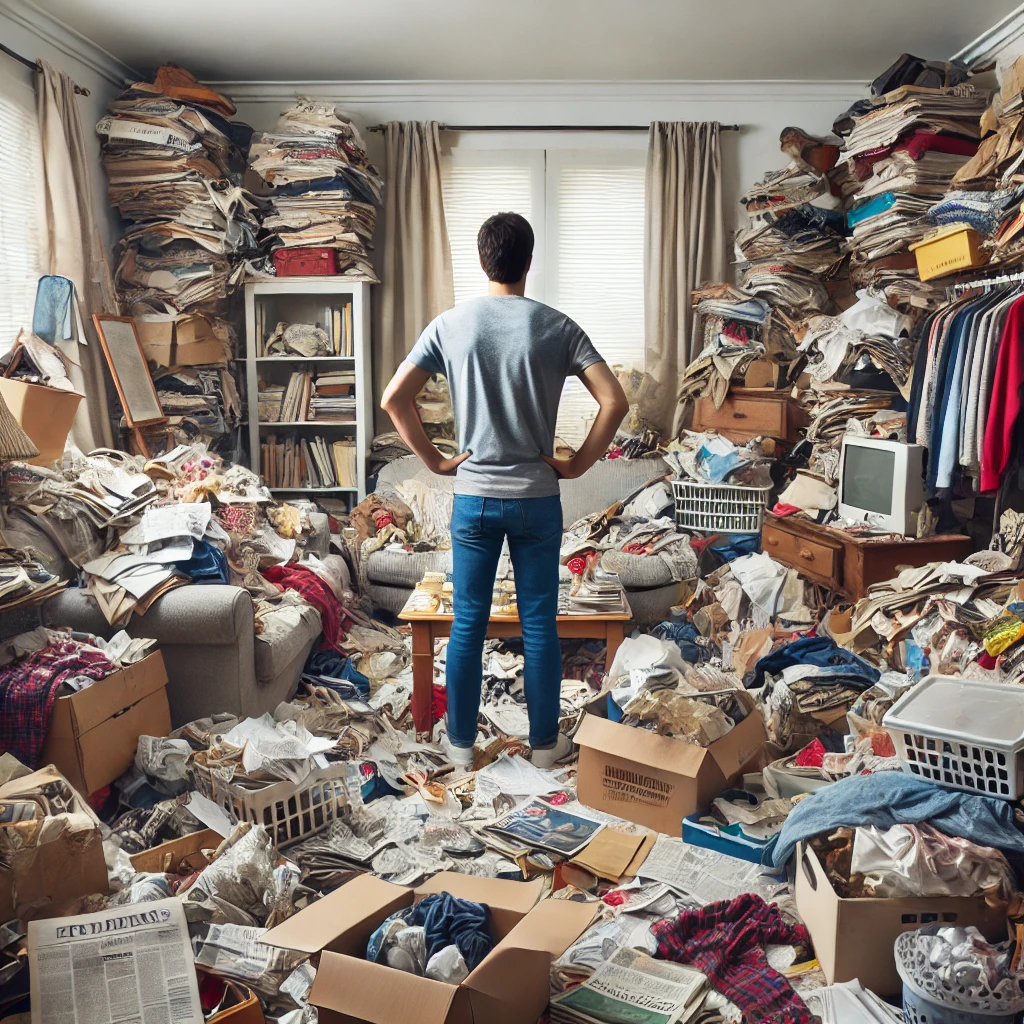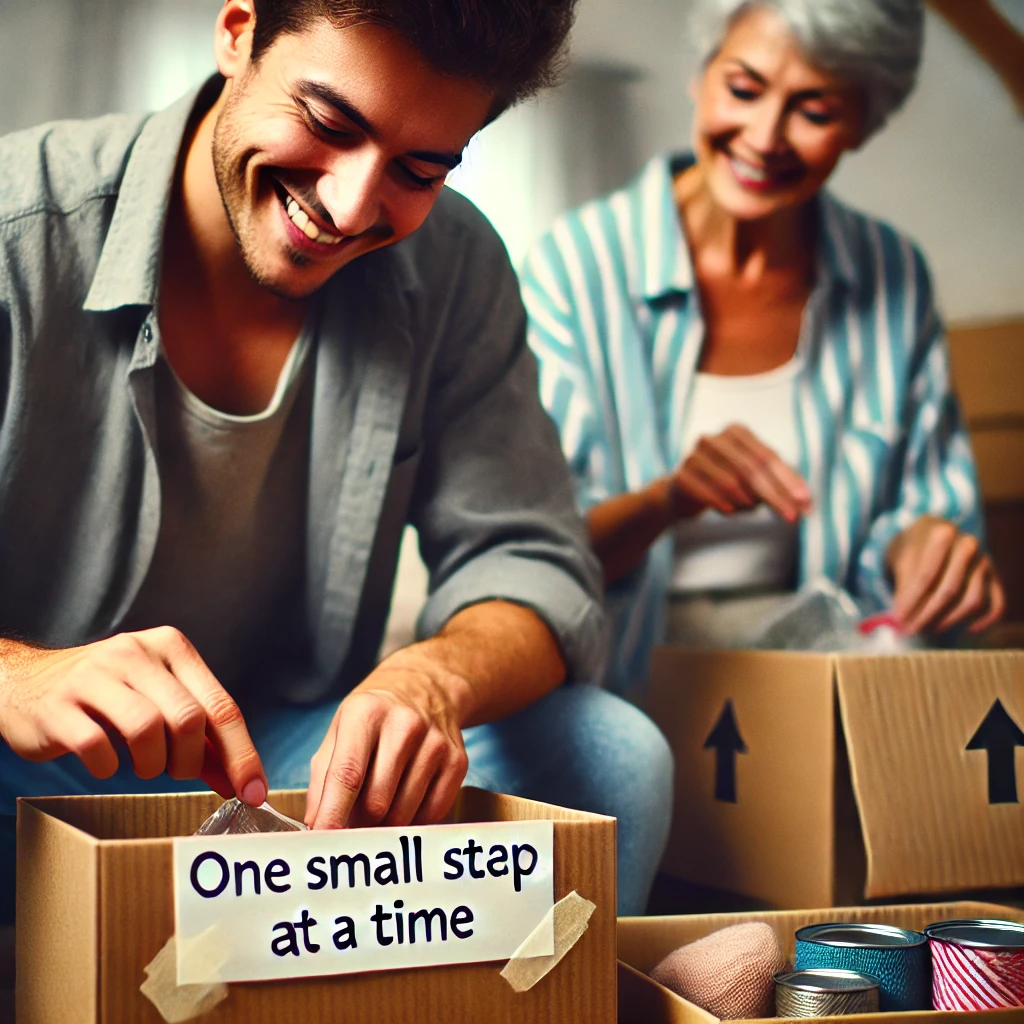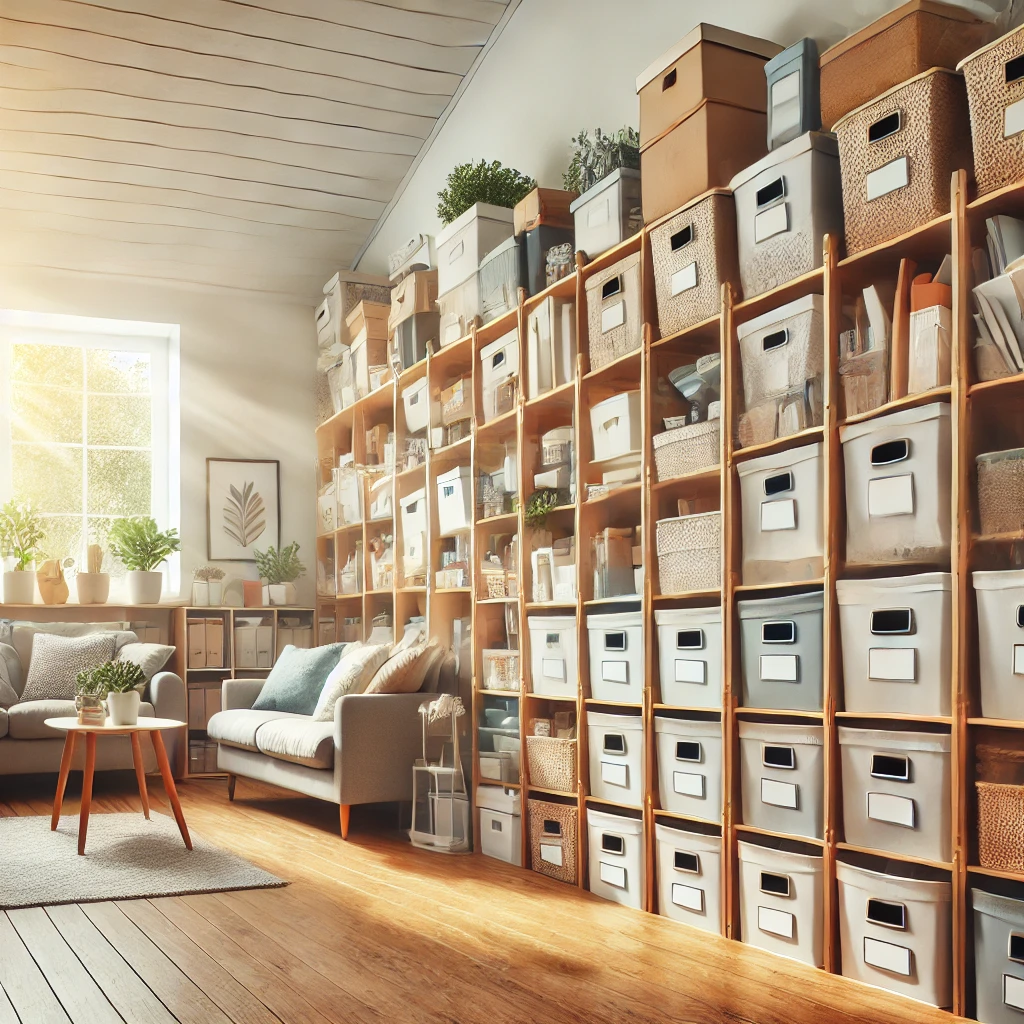You see the mess, but they see memories. You want to help, but they feel attacked.
Hoarding isn’t just clutter—it’s fear, attachment, and pain wrapped in every object. You may have tried to clean up, begged them to let go, even thrown things away when they weren’t looking. But it only made things worse.
Table of Contents
The truth? How to help a hoarder isn’t about cleaning. It’s about understanding. It’s about gaining their trust, not forcing change. The more you push, the more they cling to their things.
So where do you start? How do you help someone who doesn’t think they need it? This guide will walk you through compassionate, step-by-step strategies to help a hoarder without breaking your relationship. Because this isn’t about the mess—it’s about them.

Struggling to support a partner or family member through hoarding habits? Our shared closet survival guide dives into organizing with empathy (and boundaries).
When someone isn’t ready to let go, giving their memories a safe home is a powerful first step. This Livememory decorative storage box is soft-sided, foldable, and ideal for preserving sentimental items without shame or pressure. It invites calm progress—not forced purging—and offers a way to honor the past while slowly creating space for the present.
What Is Hoarding Disorder and How to Help a Hoarder?
Hoarding disorder is more than just having too much stuff—it’s a deep psychological struggle that makes it painful to let go of possessions, even when they have little to no value. People with hoarding disorder often feel an intense emotional attachment to objects, believing they might need them someday or that they hold irreplaceable memories.
Symptoms of hoarding disorder include extreme difficulty discarding items, excessive clutter that makes living spaces unusable, distress at the thought of getting rid of things, and social isolation. In severe cases, hoarding can lead to unsanitary conditions, health hazards, and strained relationships with loved ones. It’s not about laziness—it’s about fear, anxiety, and a need for control. If you want to know how to get help for a hoarder keep reading.
The Psychology Behind Hoarding Disorder
Hoarding disorder isn’t just about clutter—it’s deeply rooted in fear, anxiety, and emotional attachment. For a friend with hoarding disorder, every object feels like a piece of their identity, making it nearly impossible to let go. The symptoms of hoarding disorder often stem from past trauma, perfectionism, or a deep fear of losing something important.
Many hoarders struggle with decision-making and emotional regulation, leading them to hold onto things ‘just in case’ and making it even more difficult if you want to handle with how to help a hoarder. Even when the clutter causes stress, they resist help, fearing judgment or loss of control. How to help a hoarder in denial requires patience, empathy, and an understanding that forcing them to declutter can trigger panic. Before offering solutions, the most important step is to educate yourself on hoarding and the emotions behind it.
What Kind of Helper Are You?
Helping someone with hoarding tendencies is emotionally loaded. There’s no single right way—but let’s be honest, some approaches help more than others.
This quiz isn’t about judgment. It’s about understanding your instinctive style when it comes to helping—and maybe noticing a few patterns along the way. So take a breath, answer honestly, and let’s find out what kind of helper you really are.
1. Someone you love is overwhelmed by clutter. You…
2. They start resisting your help. You…
3. When it comes to clutter, your style is…
4. Your superpower as a helper is…
Step 1: Shift from Judgment to Compassion
It’s easy to look at the clutter and think, Why can’t they just throw this away? But to a friend with hoarding disorder, every item has meaning—whether it’s a stack of old newspapers, broken appliances, or piles of clothes they never wear. What seems like ‘junk’ to you may feel like security to them.
The first step to helping someone with hoarding is changing your approach. Judgment only makes them defensive. Compassion builds trust. Instead of saying, “Why are you keeping all this?”, try asking with curiosity: “Can you tell me about this item?” This simple shift makes them feel heard instead of attacked.
Hoarding is not a choice—it’s a mental health condition rooted in fear, anxiety, and past experiences. If they feel shame, they’ll cling to their things even more. But if they feel supported, they might start to see a way forward. Your role isn’t to force change—it’s to be a safe space where change can begin.

When clutter involves important papers or irreplaceable records, safety has to come first—without adding fear or shame. This fireproof document organizer offers a discreet, portable solution to protect what matters most. It doesn’t ask them to throw anything away—it simply provides peace of mind while you gently work through the overwhelm together.
Step 2: Small Steps, Not Overwhelm
Trying to declutter a hoarder’s house all at once will only lead to panic, resistance, and frustration. For someone struggling with hoarding disorder, even the thought of parting with a single item can feel like losing a piece of themselves. That’s why the key to real progress is starting small—one decision at a time.
Instead of saying, “We need to clean this whole room today,” try:
✔ The One Box Rule – “Let’s find just one box of things you don’t need.”
✔ Safe Zone Strategy – Start with a neutral area like the kitchen table, not a deeply sentimental space.
✔ Easy Wins First – Focus on broken, expired, or duplicate items to build confidence.
Each small success rebuilds trust and control, making it easier for them to let go over time. Helping someone with hoarding isn’t about speed—it’s about patience. Every step forward, no matter how small, is progress.

Progress doesn’t always mean purging—it can start with simply sorting. These stackable storage containers are clear, compact, and easy to move, making them ideal for organizing without overwhelm. Whether it’s sorting papers, small keepsakes, or “decide later” piles, they help bring order without forcing difficult decisions. Small victories. Big impact.
Step 3: When to Seek Professional Help
Sometimes, no matter how much patience and support you offer, the clutter remains—or worsens. If the situation is affecting their health, safety, or relationships, it may be time to consider professional intervention. Knowing how to help a hoarder means recognizing when the problem is beyond what you can handle alone.
Signs that professional help is needed:
✔ Severe health hazards – Mold, pests, or blocked exits creating unsafe living conditions.
✔ Emotional distress – Extreme anxiety, depression, or panic when discussing decluttering.
✔ Loss of daily function – If their hoarding prevents them from using essential spaces like the bed, kitchen, or bathroom.
✔ Legal or financial issues – Eviction warnings, unpaid bills lost in clutter, or conflicts with neighbors.
Encouraging therapy can be a delicate conversation. Instead of saying, “You need help,” try: “I’ve read that hoarding disorder is really tough to deal with alone—would you be open to talking to someone who understands?” Cognitive Behavioral Therapy (CBT) has been proven effective in treating hoarding disorder, helping individuals manage their attachment to objects, fear of loss, and decision-making struggles.
If they refuse professional help, don’t push—continue offering compassion and small steps. Change won’t happen overnight, but your support can be the bridge to healing when they’re ready.

Sometimes the easiest place to start isn’t the most obvious. The kitchen can be a powerful first step—check out our kitchen clutter purge for a low-pressure entry point.
The Dos and Don’ts of Helping a Hoarder
Knowing how to help a hoarder means understanding that decluttering isn’t just about cleaning—it’s about trust, emotions, and deep-seated fears. If you approach the situation the wrong way, you risk pushing them further into isolation. The key is to help, not force. Here’s what to do—and what to avoid:
✅ DO:
✔ Be patient – Hoarding disorder develops over years, so it won’t be fixed in a day.
✔ Use gentle language – Instead of “This is a mess,” say “Let’s create a space where you feel comfortable.”
✔ Start small – A single drawer, one box, or a few expired items can be a huge step forward.
✔ Offer choices – Instead of deciding for them, ask questions like “Which of these items means the most to you?”
✔ Celebrate progress – Every small step is a win, even if it’s just talking about decluttering.
❌ DON’T:
❌ Force them to throw things away – This triggers anxiety and makes them more resistant.
❌ Declutter behind their back – They will notice, and it will break their trust.
❌ Shame them for their living conditions – Hoarding is a mental health disorder, not laziness.
❌ Overwhelm them with big cleanouts – Large-scale decluttering can feel traumatizing, leading to even more hoarding in the future.
Knowing how to help a hoarder means meeting them where they are—not where you think they should be. When they feel understood instead of judged, they’ll be more open to change.
How to Help a Hoarder Who Doesn’t Want Help
One of the hardest parts of helping someone with hoarding disorder is when they refuse to accept that there’s a problem. They might see their clutter as normal or even feel like you’re attacking their way of life. So what do you do when they don’t want help?
The first step in how to help a hoarder who is in denial is to shift your approach from fixing to supporting. Pushing them too hard will only make them more defensive. Instead, try these gentle, non-confrontational strategies:
✔ Lead by Example – Declutter your own space and talk about how it helps you feel less stressed. Show them the benefits of organization without forcing them to do the same.
✔ Reframe the Conversation – Instead of saying “Let’s clean this mess,” try “Would you like more space to do things you enjoy?” Hoarders often respond better to positive motivation than criticism.
✔ Ask, Don’t Tell – Instead of demanding they throw things away, ask open-ended questions like “Which items are the most meaningful to you?” This helps them start prioritizing without feeling pressured.
✔ Give Them Control – People with hoarding disorder often feel a deep fear of losing control. Let them make decisions at their own pace. Even small choices—like picking one area to tidy—can be a big step.
✔ Respect Their Boundaries – If they say no, don’t push. Keep the conversation open, and revisit it later when they’re more receptive.
Sometimes, the best way to help is simply being there, without judgment. Even if they aren’t ready now, your patience and understanding can be the foundation for change in the future.
When clutter makes walking a hazard, solutions need to feel safe—not shaming. These D-Line cord protectors are low-profile, self-adhesive, and simple to install. They keep walkways safer without drawing attention or creating conflict. If you’re helping someone who’s overwhelmed, this is a quiet fix with a big impact.
Encouraging Long-Term Change
Helping a hoarder isn’t just about cleaning up once—it’s about creating lasting change. Without addressing the root causes, the clutter will slowly return. If you truly want to know how to help a hoarder, the key is ongoing support, not a one-time fix.
✔ Educate Yourself on Hoarding – Hoarding disorder is a complex mental health condition. Learning about it will help you approach the situation with understanding instead of frustration.
✔ Introduce New Habits Slowly – Encourage small, manageable routines, like a one-in, one-out rule (for every new item they bring in, they must remove one). Gradual changes feel less overwhelming.
✔ Offer Emotional Support – Hoarders often struggle with fear, anxiety, and attachment to objects. Validate their emotions and remind them that letting go doesn’t mean losing everything.
✔ Help Them Create a Maintenance System – Clutter often builds up again without a system in place. Work together to set up designated spaces, donation routines, and regular decluttering check-ins.
✔ Be Patient and Stay Supportive – Hoarding isn’t just a habit—it’s a mindset. Long-term change takes time. Even if progress is slow, your support can make all the difference.
By focusing on education, emotional support, and new habits, you’re not just helping them clean up—you’re helping them reclaim their space and their life.

If you’re emotionally invested in helping someone declutter, don’t miss our raw take on cleaning as therapy. It’s not always about the mess—it’s what the mess is hiding.
If you truly want to understand the “why” behind the piles, this book is a powerful place to start. Stuff: Compulsive Hoarding and the Meaning of Things blends psychology, real stories, and empathy to unpack the emotional weight behind hoarding. It’s not about blame—it’s about seeing the person behind the clutter. Whether you’re helping a loved one or trying to make sense of your own space, this read stays with you.
Helping Without Hurting
Knowing how to help a friend with hoarding disorder isn’t about forcing them to clean—it’s about helping them feel safe enough to change. Hoarding disorder is deeply emotional, and pushing too hard can do more harm than good. But with patience, understanding, and small, steady steps, progress is possible.
Start with compassion, not judgment. Focus on small wins instead of overwhelming cleanouts. If they resist help, stay supportive and plant the seeds for future change. And if their safety or well-being is at risk, don’t be afraid to encourage professional intervention.
You won’t fix everything overnight. But every act of kindness, every conversation, and every small step forward matters. Your support could be the difference between staying stuck in the clutter and finally finding a way out.
💙 Love decluttering and organization tips? Follow us on Facebook and Pinterest for daily inspiration, smart storage hacks, and motivation to create a clutter-free life! Let’s make tidying up feel effortless and rewarding. Join our community today! 🎯✨
Pellentesque tellus
Lorem ipsum dolor sit amet, consectetur adipiscing eli.
Phasellus luctus
Lorem ipsum dolor sit amet, consectetur adipiscing eli.
Etiam sodales
Lorem ipsum dolor sit amet, consectetur adipiscing eli.
Nullam eu sem
Lorem ipsum dolor sit amet, consectetur adipiscing eli.
Pellentesque tellus
Lorem ipsum dolor sit amet, consectetur adipiscing eli.
Phasellus luctus
Lorem ipsum dolor sit amet, consectetur adipiscing eli.
Etiam sodales
Lorem ipsum dolor sit amet, consectetur adipiscing eli.
Nullam eu sem
Lorem ipsum dolor sit amet, consectetur adipiscing eli.
Pellentesque tellus
Lorem ipsum dolor sit amet, consectetur adipiscing eli.
Phasellus luctus
Lorem ipsum dolor sit amet, consectetur adipiscing eli.
Etiam sodales
Lorem ipsum dolor sit amet, consectetur adipiscing eli.
Nullam eu sem
Lorem ipsum dolor sit amet, consectetur adipiscing eli.
Pellentesque tellus
Lorem ipsum dolor sit amet, consectetur adipiscing eli.
Phasellus luctus
Lorem ipsum dolor sit amet, consectetur adipiscing eli.
Etiam sodales
Lorem ipsum dolor sit amet, consectetur adipiscing eli.
Nullam eu sem
Lorem ipsum dolor sit amet, consectetur adipiscing eli.

One response
Your writing is a beautiful reminder that the simplest ideas can often carry the most profound truths.